Explore the latest news and find out what's on this month
Explore our learning offer for schools, families and community groups
Uncover the rich history of Elmbridge with our latest online exhibitions
Want to discover more about your local area?
Explore the latest news and find out what's on this month
Explore our learning offer for schools, families and community groups
Uncover the rich history of Elmbridge with our latest online exhibitions
Want to discover more about your local area?
 High Street Walton, looking from the War Memorial. Shows the Kiwi pub. Taken before December 1972, when United Dairies closed down.
High Street Walton, looking from the War Memorial. Shows the Kiwi pub. Taken before December 1972, when United Dairies closed down.
A number of images may spring to mind upon hearing the words ‘High Street’. Perhaps it’s the steady buzz of locals going about their daily lives, performing all of their usual rituals. Maybe it’s the friendly smiles of the local shopkeepers, or the memory of bumping into a neighbour. It could be something more specific – for some, the lasting image of the high street will always be the way it was in the coronavirus pandemic. The concept of the high street is universally recognised, yet its meaning and identity remain slightly different for everyone.
This online exhibition follows on from Elmbridge at War by investigating the evolution of our much-loved local High Streets and primary shopping streets of Elmbridge from the 1950s, 60s and 70s up to the present day.
This trail brings to life the history of businesses and buildings across Walton and Weybridge by displaying a panel in each collaborating store. Each panel will outline the building’s past and track it’s story from ‘then’ to ‘now’ using historic items and photos in Elmbridge Museum’s collection.
History panels can now be viewed in local stores at:
Weybridge
1. Century 21
2. Church House Antiques
3. Curchods
4. Eyesite Opticians
5. Maya
6. Princess Alice Hospice
7. Weybridge Audio
8. Weybridge Library
9. Weybridge Post Office
Walton
10. Click, Save & Print
11. Elmbridge Community Hub
12. Explore Learning
13. Rentstart
14. The 1955 Club
15. Walton Library
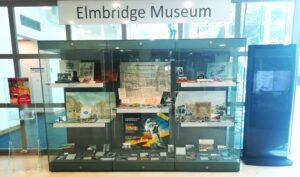
The Historic High Streets Exhibition at Elmbridge Borough Council’s Civic Centre, Esher High Street, April 2021 – 2022.
From December 2020, Elmbridge Museum sent out an appeal for contributions of memories and photographs to display in our Historic High Streets exhibition. The response was fantastic, resulting in over 60 contributions gathered together for a community-curated exhibition.
Below, with the help of some of those community curations, we explore the impressions that Elmbridge’s historic high streets have left with the people of our borough, as well as drawing upon the huge number of items in our own Museum archive. At the core of each memory, photograph and item displayed, the community’s ever-changing identity shines through. This online exhibition uses them all to uncover how the individuals who live, shop, socialise and work in Elmbridge have, in turn, shaped our high streets over the years.
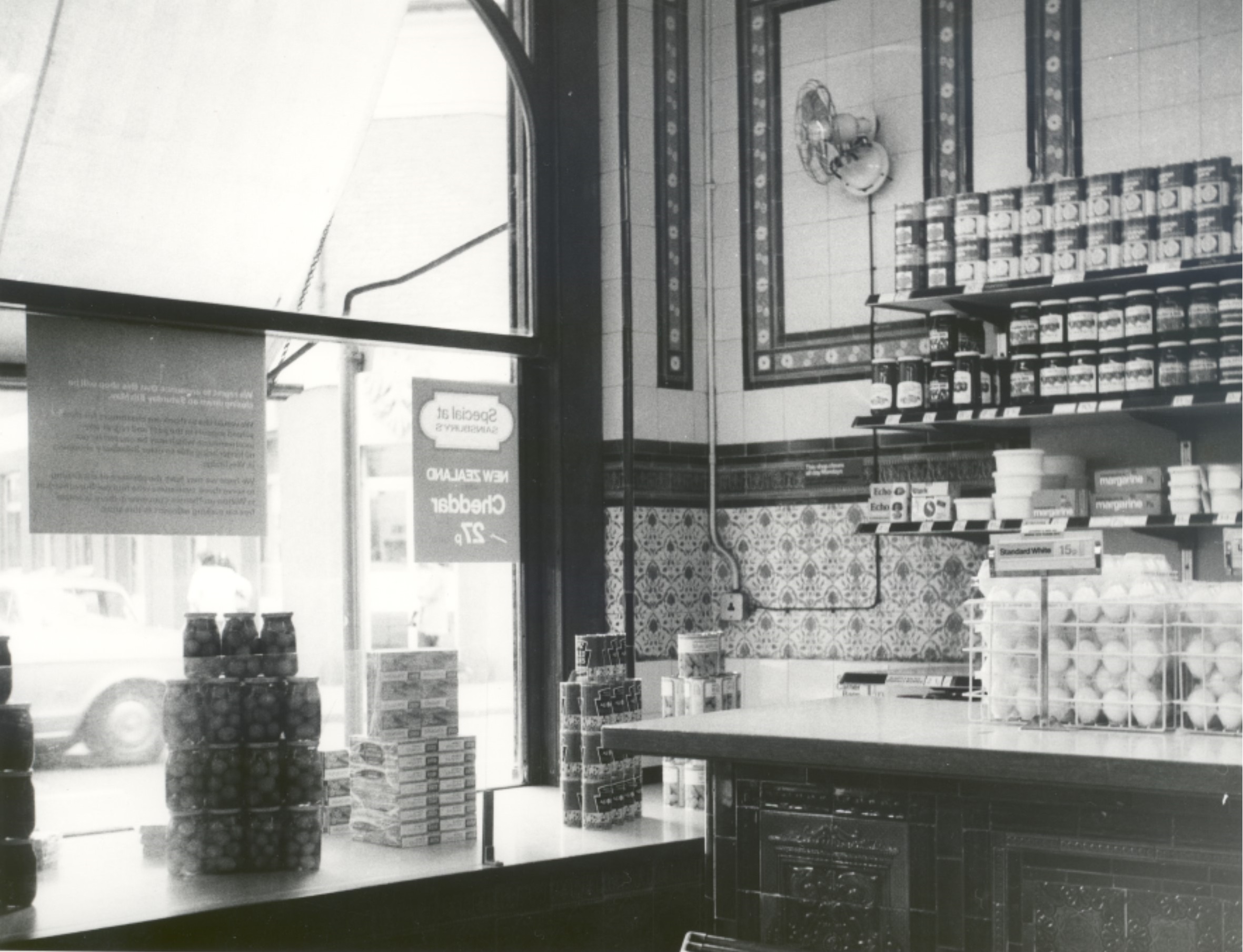 Inside Sainsbury's Weybridge, 1970. Embossed tiles can be seen on the walls.
Inside Sainsbury's Weybridge, 1970. Embossed tiles can be seen on the walls.
One of the High Street’s main functions from the 1950s onwards centred around food shopping. In the 1950s, small stores which stocked the essentials were the norm.
Sainsbury’s first opened in Weybridge as early as 1920, as a small grocers store, and a colourful array of glazed tiles were specially made for their counters and windows by Minton’s of Stoke-on-Trent. Another small Sainsbury’s much like this one opened up in 1954 in Walton High Street, closing in 1970.
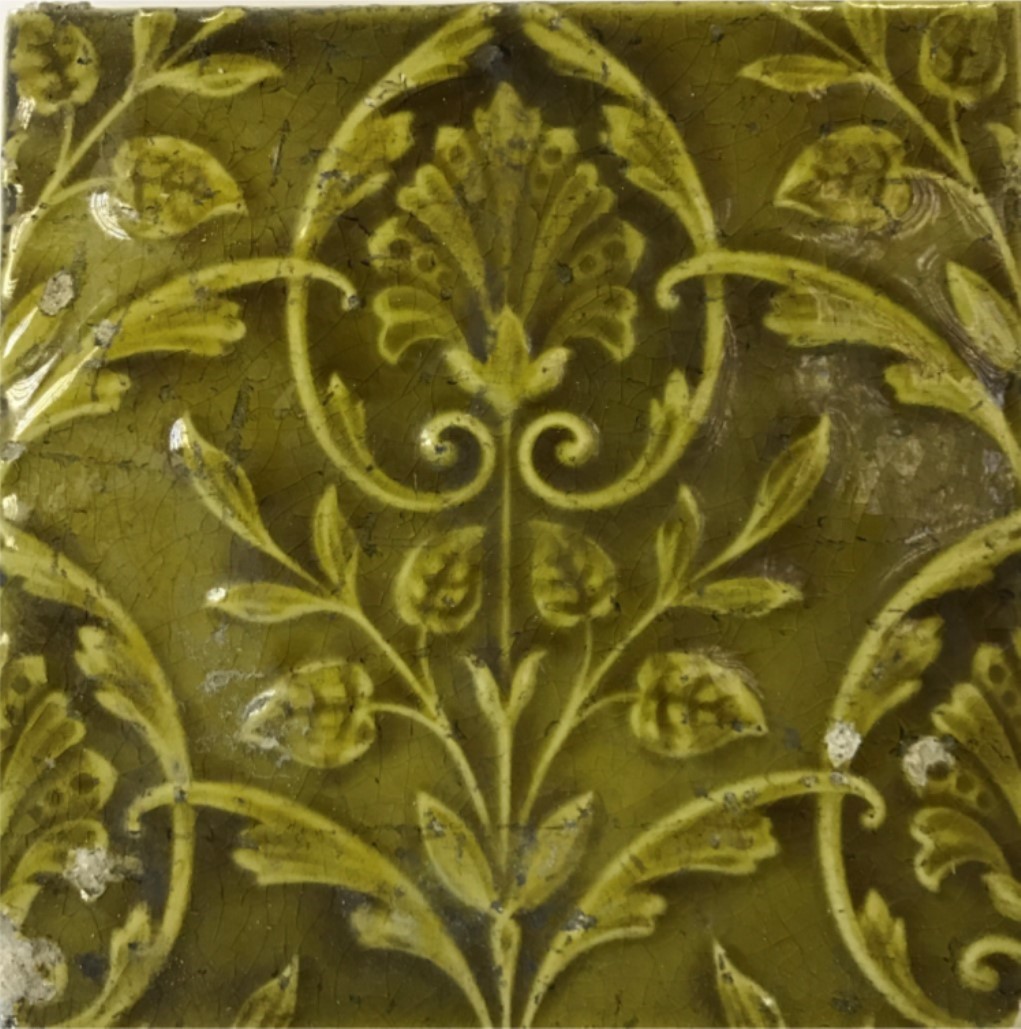 Green embossed tile from Sainsbury's Weybridge.
Green embossed tile from Sainsbury's Weybridge.
By the time rationing had ended in 1954, and thanks to a steady rise in consumption in the 1960s, the majority of High Streets featured a supermarket by the 1970s. Indeed, on 5th Mary 1973, the very same year that the huge Waitrose opened its doors in Weybridge, the smaller Sainsbury’s branch there closed for good, with the company issuing a letter to its customers explaining that it had become “inadequate to meet the present day needs” of customers and “impossible to operate… economically” there. They directed customers to their new large Walton branch at 11-15 Bridge Street instead.
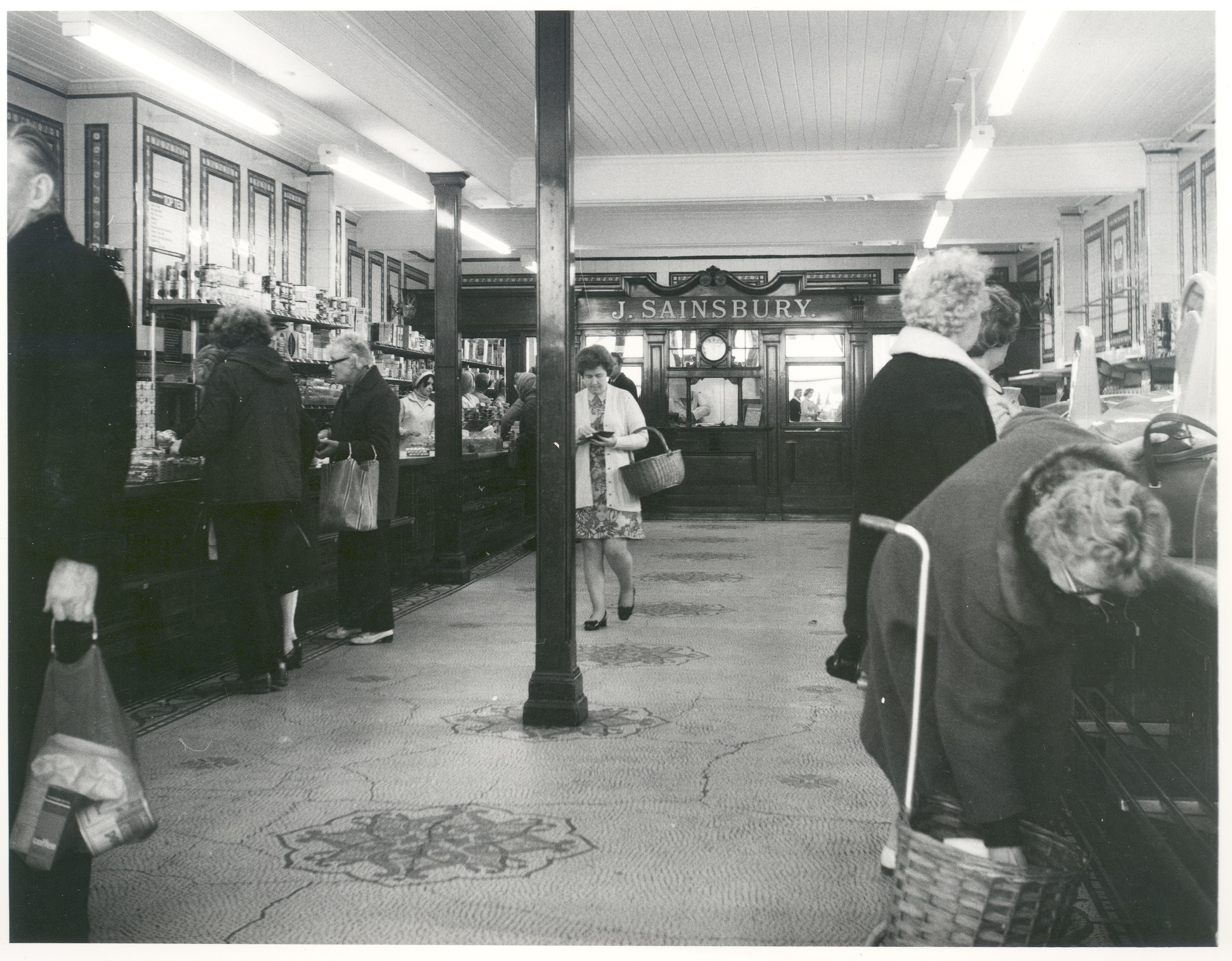 Inside of J. Sainsbury's shop in Weybridge High Street, c.1970s.
Inside of J. Sainsbury's shop in Weybridge High Street, c.1970s.
 Sainsbury's Potted Meat jar in white earthenware, c.1960s
Sainsbury's Potted Meat jar in white earthenware, c.1960s 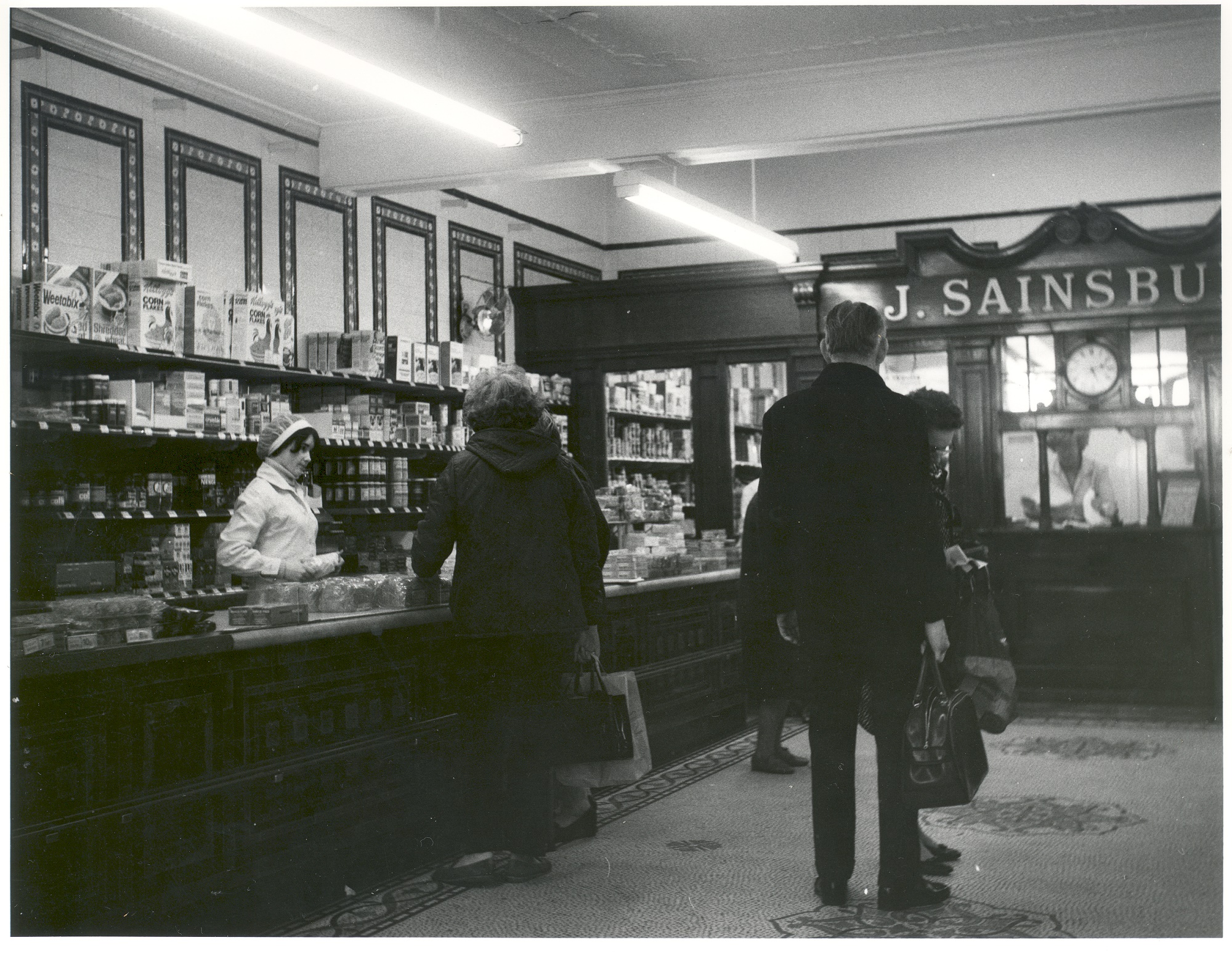 The inside of J. Sainsbury's shop, Weybridge c.1970s, showing an assistant behind the left counter and a group of 5 people standing beside the counter. The cash office can be seen on the right.
The inside of J. Sainsbury's shop, Weybridge c.1970s, showing an assistant behind the left counter and a group of 5 people standing beside the counter. The cash office can be seen on the right.
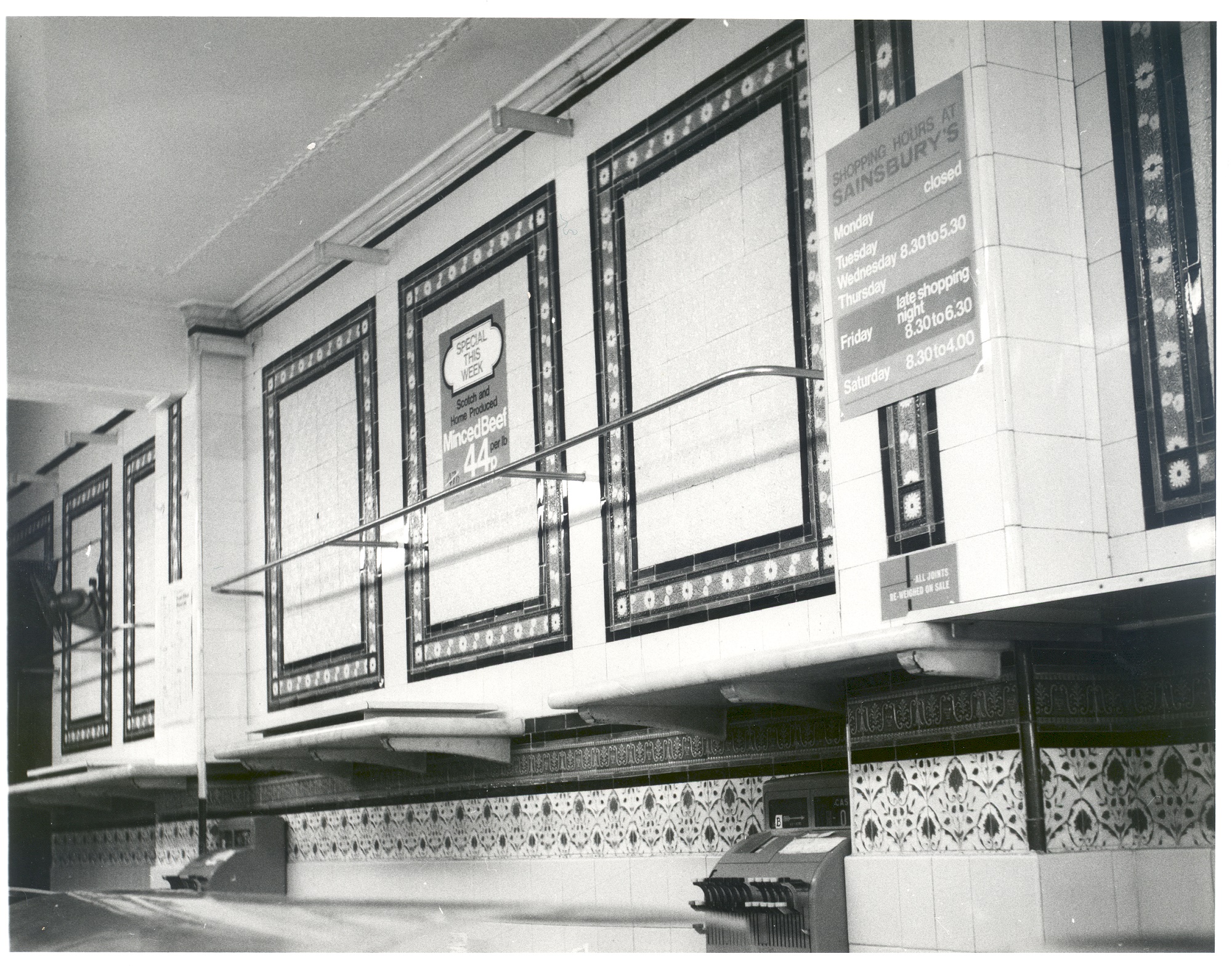 Photograph of J. Sainsbury's shop in Weybridge c.1970s, showing cleared shelves and counters with 2 cash registers at the back.
Photograph of J. Sainsbury's shop in Weybridge c.1970s, showing cleared shelves and counters with 2 cash registers at the back. 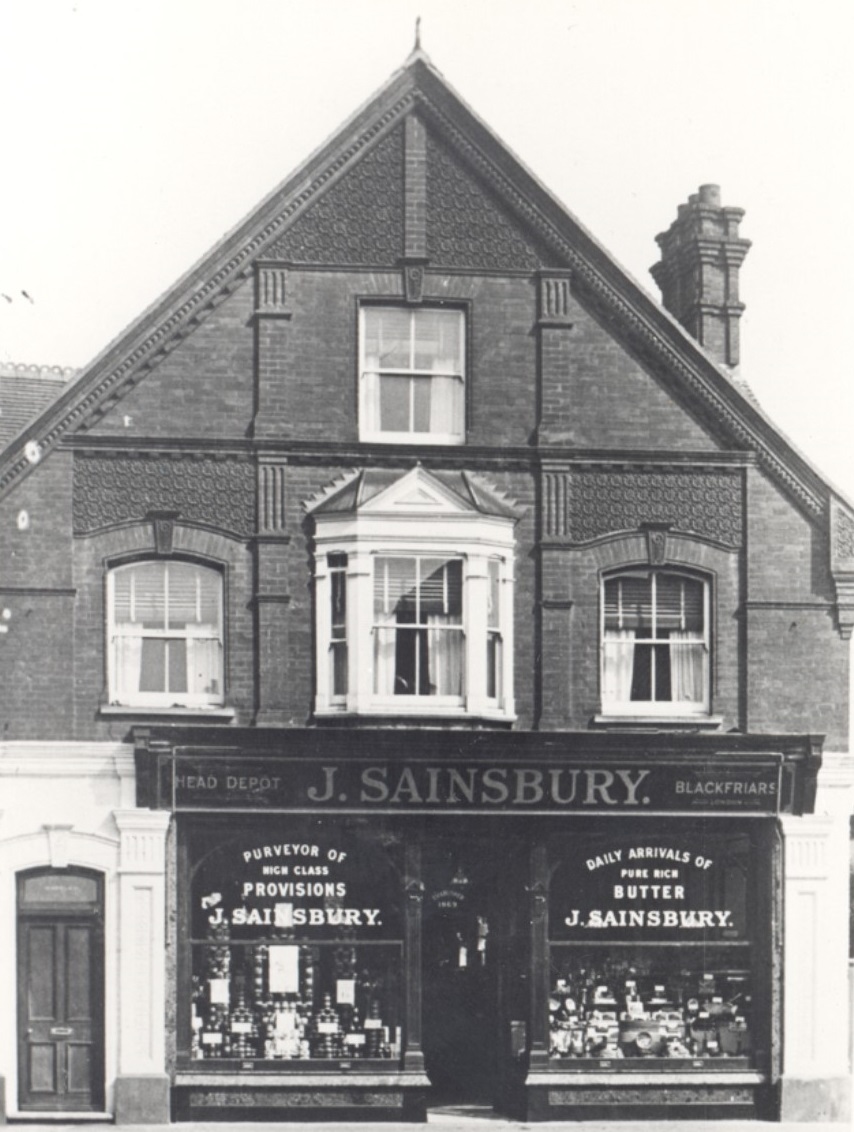 Photograph of Sainsbury's shop in Church Street, Weybridge, showing pointed gable, windows over shop front, shop front and front door of flat above. Photograph taken about 1932, when Sainsbury's first opened in this building.
Photograph of Sainsbury's shop in Church Street, Weybridge, showing pointed gable, windows over shop front, shop front and front door of flat above. Photograph taken about 1932, when Sainsbury's first opened in this building.
 Black & white photograph of west end of Baker Street looking west, with Toba and Mann & Co. on left and part of Church Street in background including fish and chip shop, Shoppers Paradise & former Sainsbury's building, 1978.
Black & white photograph of west end of Baker Street looking west, with Toba and Mann & Co. on left and part of Church Street in background including fish and chip shop, Shoppers Paradise & former Sainsbury's building, 1978. The closure of Sainsbury's in Weybridge in 1973 disappointed many.
From Sainsbury’s to its Weybridge customers
Store: E. Lock’s, Grocery
Location: 41 High Street, Weybridge
What is it now? Bridge House
Edwin Lock designed and built his own grocers shop in Weybridge High Street in 1931. As the area evolved, many of the old stores near the York Column were redeveloped. The large Waitrose supermarket took prominence on its opening in 1973, and is opposite where Lock’s store once was.
Find out more about Edwin and the items from his shop in this Behind the Scenes video.
As well as running his grocery store, Edwin Lock was a creative man, and an avid painter. In his later years, he painted colourful scenes of Weybridge’s main streets, many of which remain preserved in our collection.
Take a look at some originals of Lock’s brilliant work below.
Oil painting of the Duchess of York's Monument at Monument Green, Weybridge, showing houses in background and trees on
either side of the Monument.
Watercolour of the West Gate, entrance of St. George's Hill, Weybridge. A house stands to the left of the gate.
Watercolour of "Robin's Nest", cottage in High Street, Weybridge - now demolished.
Watercolour of the rear of "Robin's Nest", cottage in High Street, Weybridge, now demolished.
Watercolour, pen and ink sketch of "The Clockhouse", Hanger Hill, Weybridge.
Oil painting of the entrance to Springfield Lane, Weybridge. Painting shows wall on right and houses behind wall.
Oil Painting of an Old Chestnut tree, which stood near the 'Ship Inn', High Street, Weybridge. Copy of an old painting dated 1882.
Oil painting of old shops in the High Street, Weybridge. The butchers Seaman & Sons can be seen on the far left.
Fine Fare supermarket opened in Cobham High Street in 1963, to much popular press coverage. It was the first true supermarket of its kind in Cobham, and is now the site of Sainsbury’s.
Take a look through some of the community curations on Fine Fare in this section, kindly collected and donated by the Cobham Conservation & Heritage Trust.

Fine Fare, Cobham, c.1960s. Photograph courtesy of Terry Gale, contributed by Cobham Conservation & Heritage Trust.
“It was built on the site of a house and some waste ground and was opened in 1963 in a blaze of publicity with pop star Ronnie Carroll who represented the UK in the Eurovision Song contest two years running in 1962 and 1963, causing much interest for female shoppers in particular. It was instantly popular as a place to shop. It was built on the site of an old tea room and some waste ground.
The supermarket had offices and staff canteen above and a flat for the Manager on the second floor, as well as a warehouse at the back.”
“I worked there on Friday nights, Saturdays and school holidays to buy my first motorbike.
In 1966 the warehouse was downstairs at the back. I unloaded enough lorries by hand, down a conveyor belt to remember that. Upstairs was a small staff canteen and loos. Above that was the Store Manager’s flat, Mr Walker, who had a dapper moustache.
I can also remember being in the manager’s office overlooking the store through the large window. I thought I had been called up there for a telling off. Turns out I was kitted out in a waistcoat with huge pockets which were filled with bags of coins to be taken to the bank for paying in. I had to wear my parka anorak over the top to hide it. It was supposed to look inconspicuous but the weight of the coins meant I could hardly walk. A hefty member of the fruit and veg department accompanied me to the bank. Imagine that nowadays!”
The entertainment on offer is one aspect of our local High Streets which has remained constant from the 1950s to the present day. The concept of pubs and cafés dates back to the 1600s, while cinemas were introduced in the pre-war years. In recent times, some entertainment venues have faced closure, but their records in our collection still provide a fascinating insight into past community social life.
Watch the Hidden Treasures video here to see some of the items from Walton’s former Capitol Cinema held in Elmbridge Museum’s collection.

Stalls and screen curtains of the Odeon Cinema, Walton, taken on the day it closed in November 1980.
In recent decades, some local cinemas have faced closure, but their records in our collection still provide a fascinating insight into past community social life. The Regal Cinema in New Zealand Avenue changed to the ABC in 1963, and closed in 1971, and the Odeon around the corner on the High Street closed in 1980. The building stayed on as offices for 10 years until 1990, when a new development was built on the site. After a long campaign from local residents, the building finally began operating as a cinema again in 1992 when ‘The Screen’ took it over. This became the Everyman in 2008 and has stayed on as such to this day.
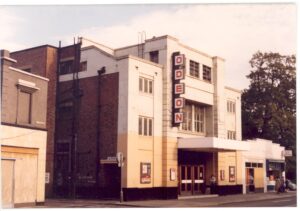
The Odeon, Walton High Street, from the left, taken on the day it closed in November 1980.
Both the original Capitol and the Regal were managed at one time by Clifford Spain, a well-known local personality who appeared in Cecil Hepworth’s films as a young boy and kept scrapbooks of the time he spent managing both premises up to the 1950s.
Some cinemas also appeared in other areas of the borough. One prominent building which is still a cinema today was the Embassy in Esher High Street. The Embassy was huge, seating up to 1,200 people in its stalls and circle around a 12-foot-deep, art-deco styled stage. As the cinema changed hands, it was renamed the Cannon in 1986 and then the ABC in 1996, and opened a much smaller additional screen where the cinema cafe once was.
The Savoy cinema in Cobham sadly did not have the same fate, becoming disused in the 1960s and demolished around 1970. It is now the site of the playing field on the Portsmouth Road.
In the Elmbridge Museum collection, there are a number of old film posters from former cinemas across the borough, from the 1950s to the 1990s. The posters – two of which can be viewed below – are revealing of popular culture in their time, and include hit blockbusters, some of which are still popular today.
Poster for ''Back to the Future'' showing at the Embassy Cinema, Esher, in December 1985 and January 1986. The poster still has its original snipe in the top right hand corner, from when it was first put up on display at the Embassy.
Poster advertising "The Awful Truth" and "Navy Blue and Gold" at The Regal Cinema, Walton, in 1937.
Some pubs such as The Bear in Esher date back to the very beginnings of the High Street. The Hare and Hounds pub, at the top of Claygate High Street, is another such pub. It is pictured here in the snow in February 1991. The cold spell in early 1991 saw up to 20 cm of snow in areas around London and the south east, and was the deepest coverage since the early 1960s.
Many pubs, however, haven’t survived – the Kiwi, later the Wellington, named for New Zealand’s troops convalescing at Walton’s Mount Felix during the Great War, sadly closed for good in 2014, having been one of the central venues in Walton High Street for many years.
Take a look through some of these community curations on Elmbridge social life. The sections on Ann’s Coffee Lounge were kindly collected and donated by the Cobham Conservation & Heritage Trust.
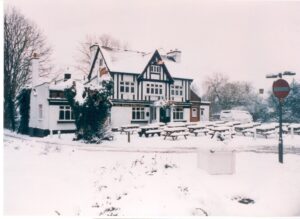
The Hare and Hounds pub, Claygate, in the snow, February 1991.
There was little for the younger generations in Cobham, until Elizabeth Ann Thomas, known as ‘Bet’, opened Ann’s Coffee Lounge in 1959, maintaining it until 1968. Bet moved to Cobham with her 16 year old son and completely transformed the cafe into a welcoming, friendly place for locals to get food and drink. She lived in Oxshott until her death.
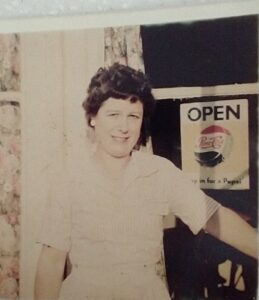
Bet Thomas, Cafe Proprietor of Ann’s Café, 1961. Photo courtesy of Tracey Ferris, contributed by Cobham Conservation & Heritage Trust.
“It served the first frothy coffee in Cobham…and was frequented by motorbike boys and girls so the Mods on scooter tried to get past it pretty quick! It had a great jukebox too.”
“As well as frothy coffee and the jukebox it had an orange juice with a large tank full of orange juice and a plastic orange bobbing around on the top.”
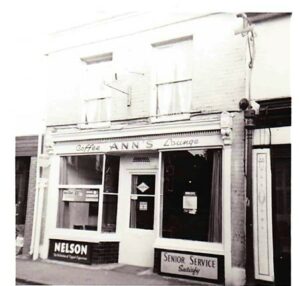
Ann’s Coffee Lounge at 9 Church Street, Cobham. Photo courtesy of Tracey Ferris, contributed by Cobham Conservation & Heritage Trust.
“There was an old fashioned tea shop on the left of the High Street with a waitress and china cups and a warm welcome. Further down on the right was a small Sainsbury’s were you had to queue twice, once for dairy products and once for other items. I once queued behind a famous actress who lived in Walton at that time but whose name I’ve forgotten! At the other end of the High Street was the library, and opposite was a large cinema. That was where the Village bus picked up Villagers who had come in to shop, and visitors who had no cars.”
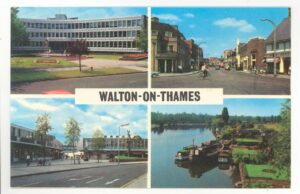
A postcard showing some of the primary shopping streets in Walton, as well as boats on the river Thames. All of the photos were taken in the 1960s.
My grandma worked in Paynes. Her name was Dorothea Wells (nee Coleman), known as Dorothy or Dol. I’d love for Sandra K to get in touch with any memories she has of her.
To Pat C - the famous actress you were stood behind in Woolworths could well have been Julie Andrews (Julia Wells) who is my 2nd cousin.
You need to be logged in to comment.
Go to login / registerLibraries remain a significant feature of our local high streets, albeit often in modern and updated venues.
Since the post-war years, local libraries have hosted many key community events: from book fairs, to Elmbridge Museum’s local history talks and displays. In 2008, Walton Library moved from its old school building at the bottom of the High Street to the Heart shopping centre.
Weybridge Museum was initially founded in 1909, but it was only in 1965 that permanent staff were appointed. Public lectures given by museum staff were often delivered in collaboration with local library venues such as Walton and Weybridge, as well as craft events for children, for which colourful posters still survive in our collection. A selection can be viewed in the following pages of this section.
The museum became Elmbridge Museum in 1991, with its gallery on the floor above Weybridge Library until 2014.
 A poster listing public lectures on old Walton by Dorothy Grenside (former Weybridge Museum Curator) held at the former Walton Library, 1957.
A poster listing public lectures on old Walton by Dorothy Grenside (former Weybridge Museum Curator) held at the former Walton Library, 1957. 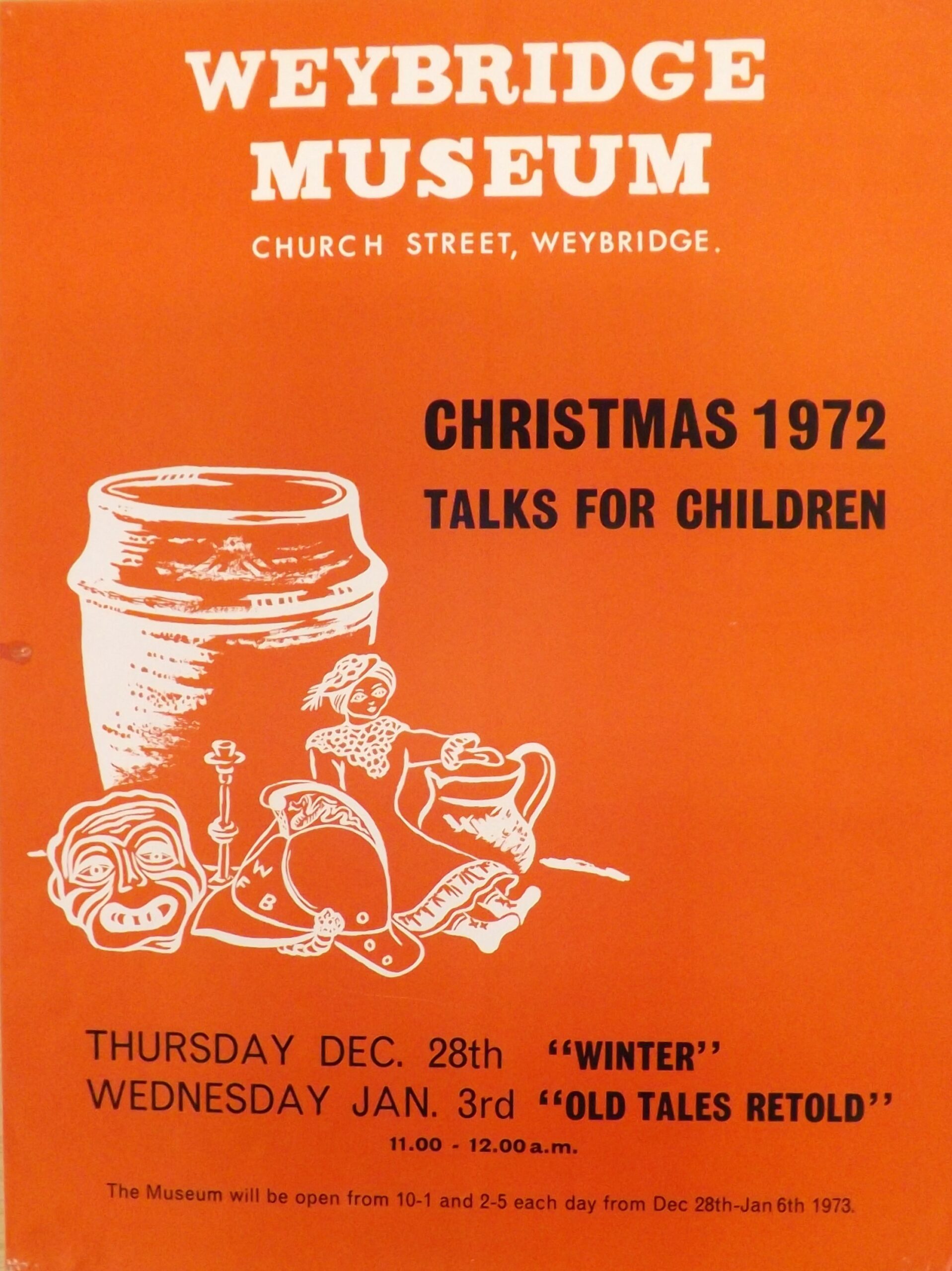 Museum poster from Weybridge Museum (now Elmbridge Museum) advertising 'Christmas Talks for Children' in 1972 that were put on in their former gallery space above Weybridge Library, Church Street.
Museum poster from Weybridge Museum (now Elmbridge Museum) advertising 'Christmas Talks for Children' in 1972 that were put on in their former gallery space above Weybridge Library, Church Street.
 Museum poster from Weybridge Museum (now Elmbridge Museum) advertising an 'Oatlands Palace Excavated Material' exhibition in 1982, in their former gallery space above Weybridge Library, Church Street.
Museum poster from Weybridge Museum (now Elmbridge Museum) advertising an 'Oatlands Palace Excavated Material' exhibition in 1982, in their former gallery space above Weybridge Library, Church Street. 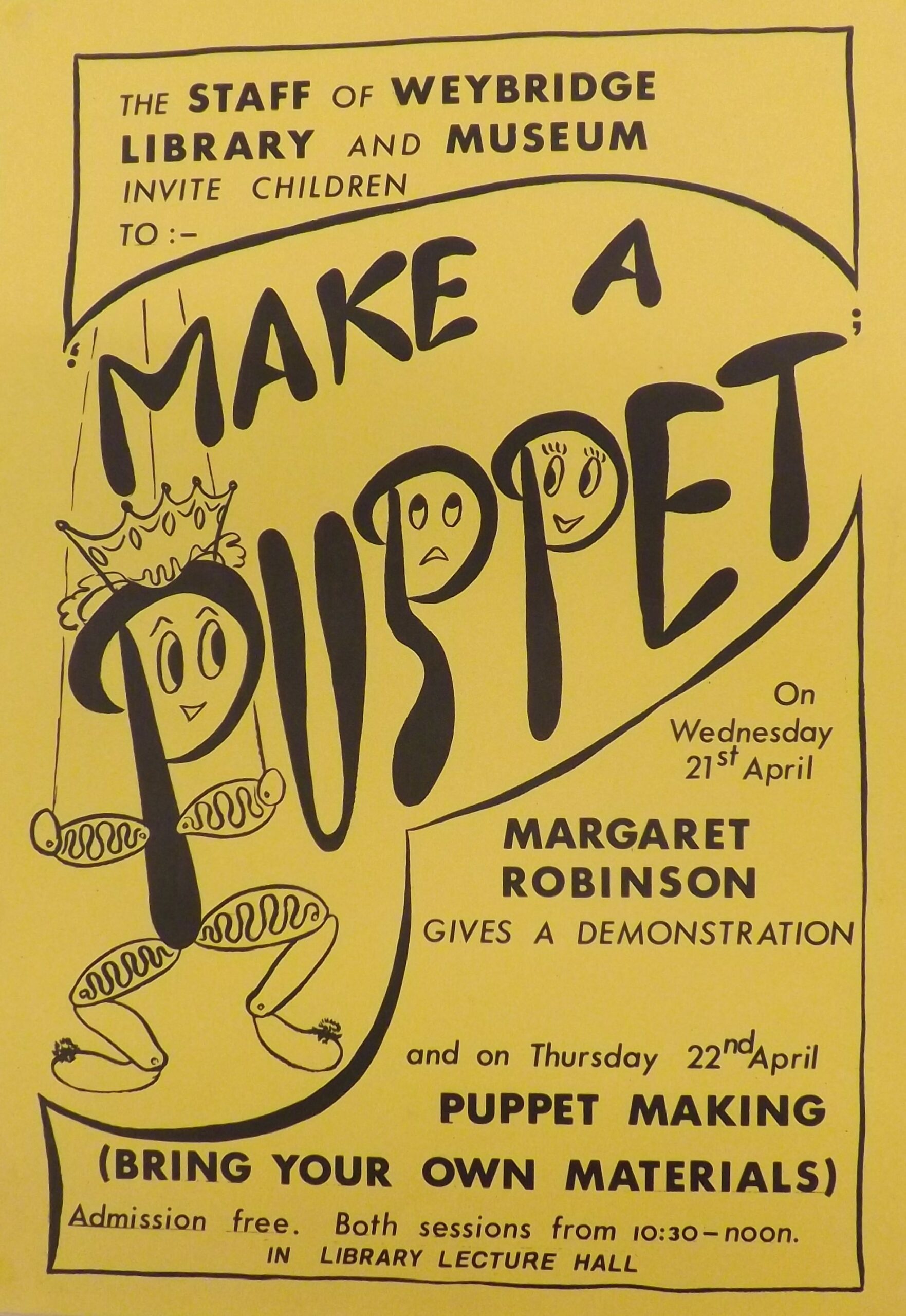 Museum poster from Weybridge Museum (now Elmbridge Museum) advertising their 'Make a Puppet' children's workshop that was put on in their former gallery space above Weybridge Library, Church Street, c.1970-80s.
Museum poster from Weybridge Museum (now Elmbridge Museum) advertising their 'Make a Puppet' children's workshop that was put on in their former gallery space above Weybridge Library, Church Street, c.1970-80s.
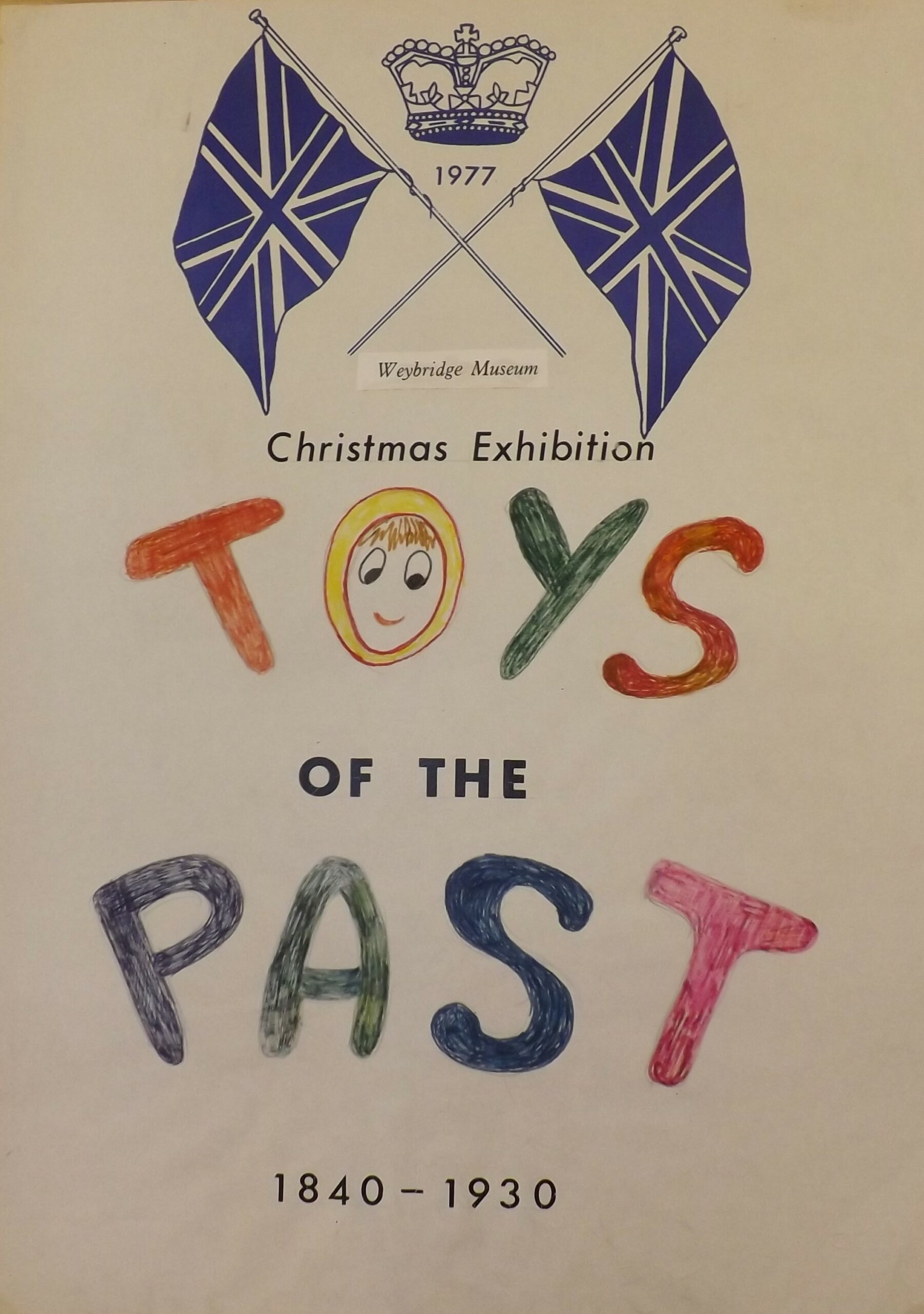 Museum poster from Weybridge Museum (now Elmbridge Museum) advertising their 'Toys of the Past' exhibition in 1977, in their former gallery space above Weybridge Library, Church Street.
Museum poster from Weybridge Museum (now Elmbridge Museum) advertising their 'Toys of the Past' exhibition in 1977, in their former gallery space above Weybridge Library, Church Street. 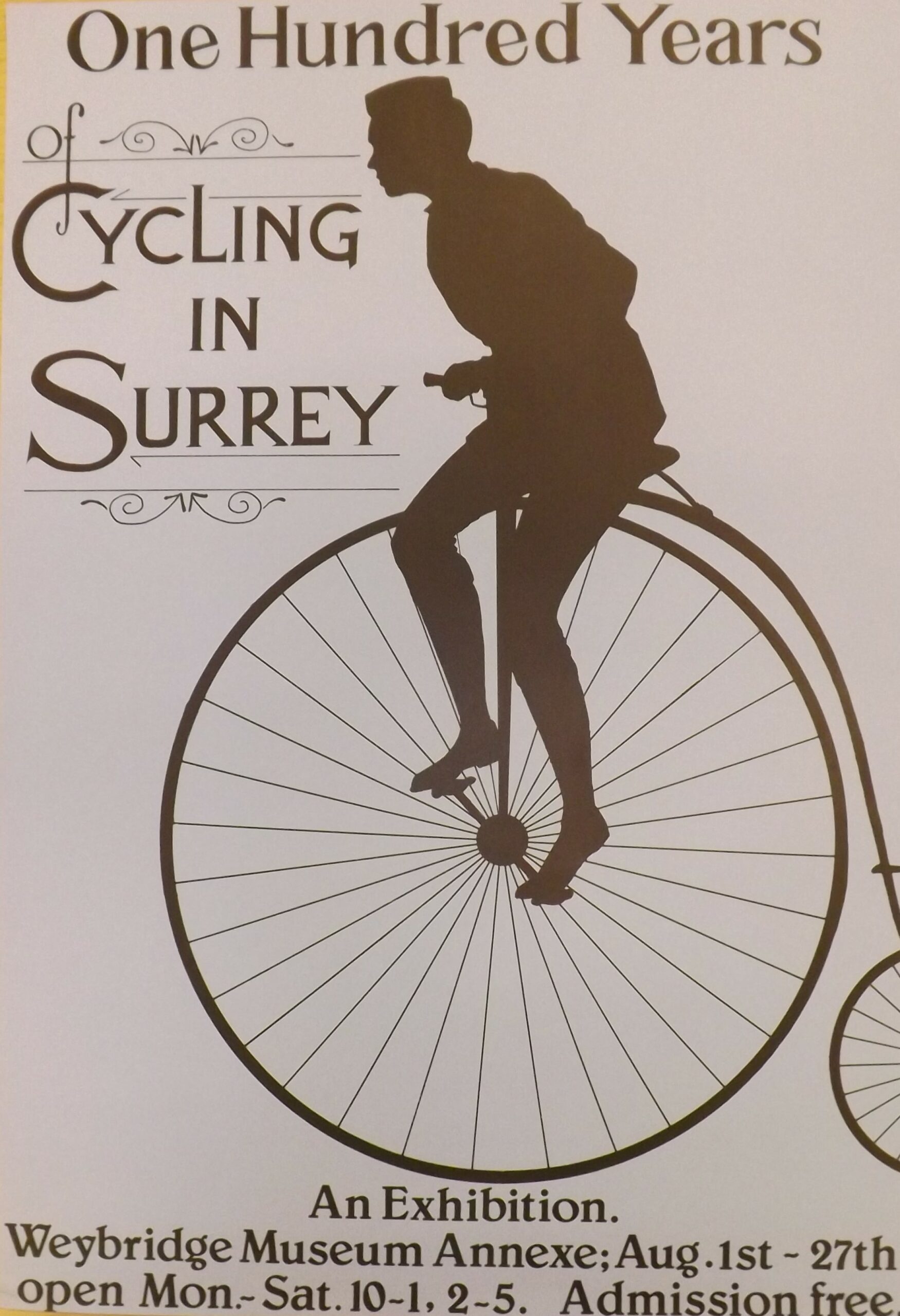 Museum poster from Weybridge Museum (now Elmbridge Museum) advertising their '100 Years of Cycling in Surrey' exhibition c.1980s, in their former gallery space above Weybridge Library, Church Street.
Museum poster from Weybridge Museum (now Elmbridge Museum) advertising their '100 Years of Cycling in Surrey' exhibition c.1980s, in their former gallery space above Weybridge Library, Church Street.
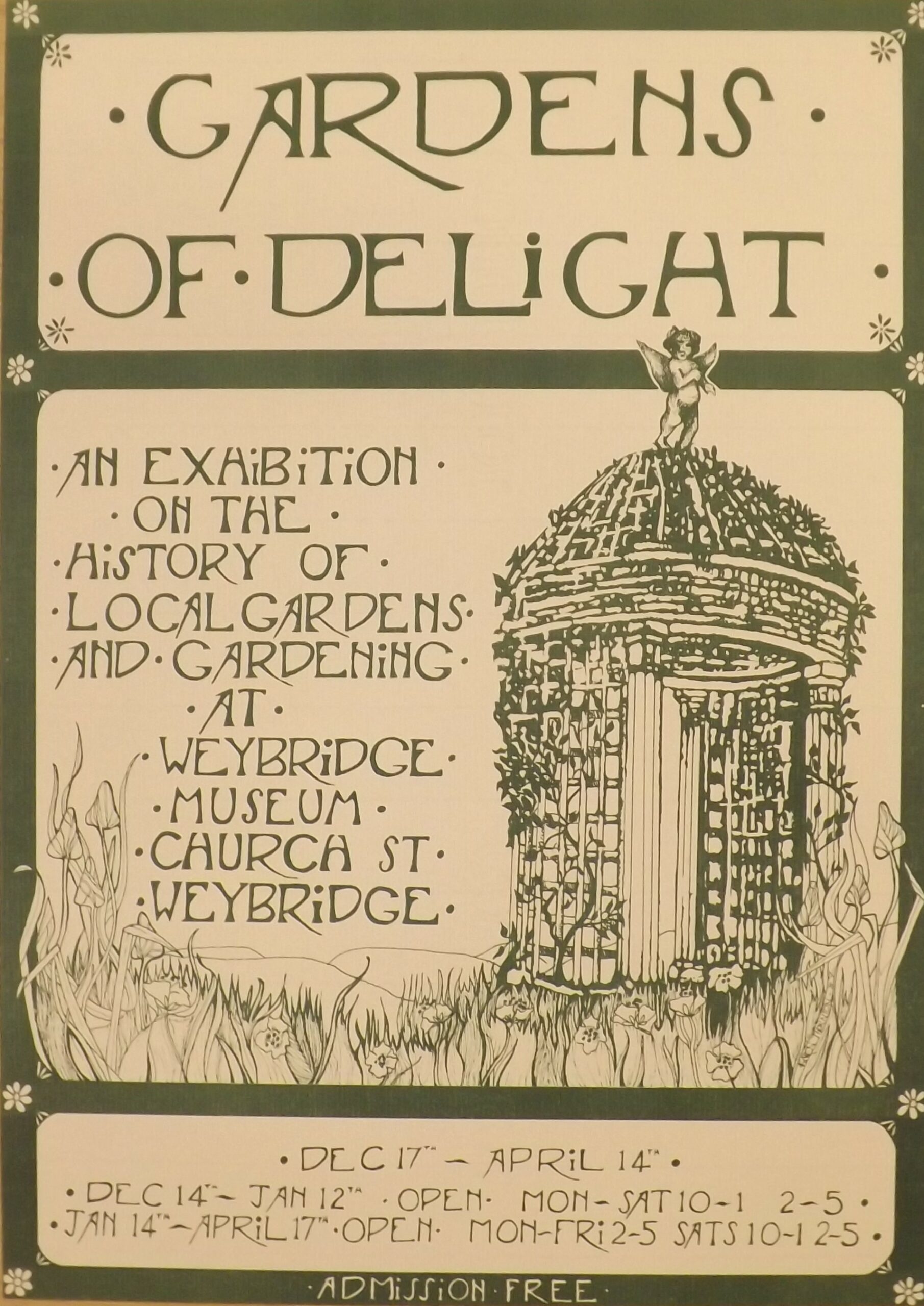 Museum poster from Weybridge Museum (now Elmbridge Museum) advertising their 'Gardens of Delight' exhibition c.1980s, in their former gallery space above Weybridge Library, Church Street.
Museum poster from Weybridge Museum (now Elmbridge Museum) advertising their 'Gardens of Delight' exhibition c.1980s, in their former gallery space above Weybridge Library, Church Street. 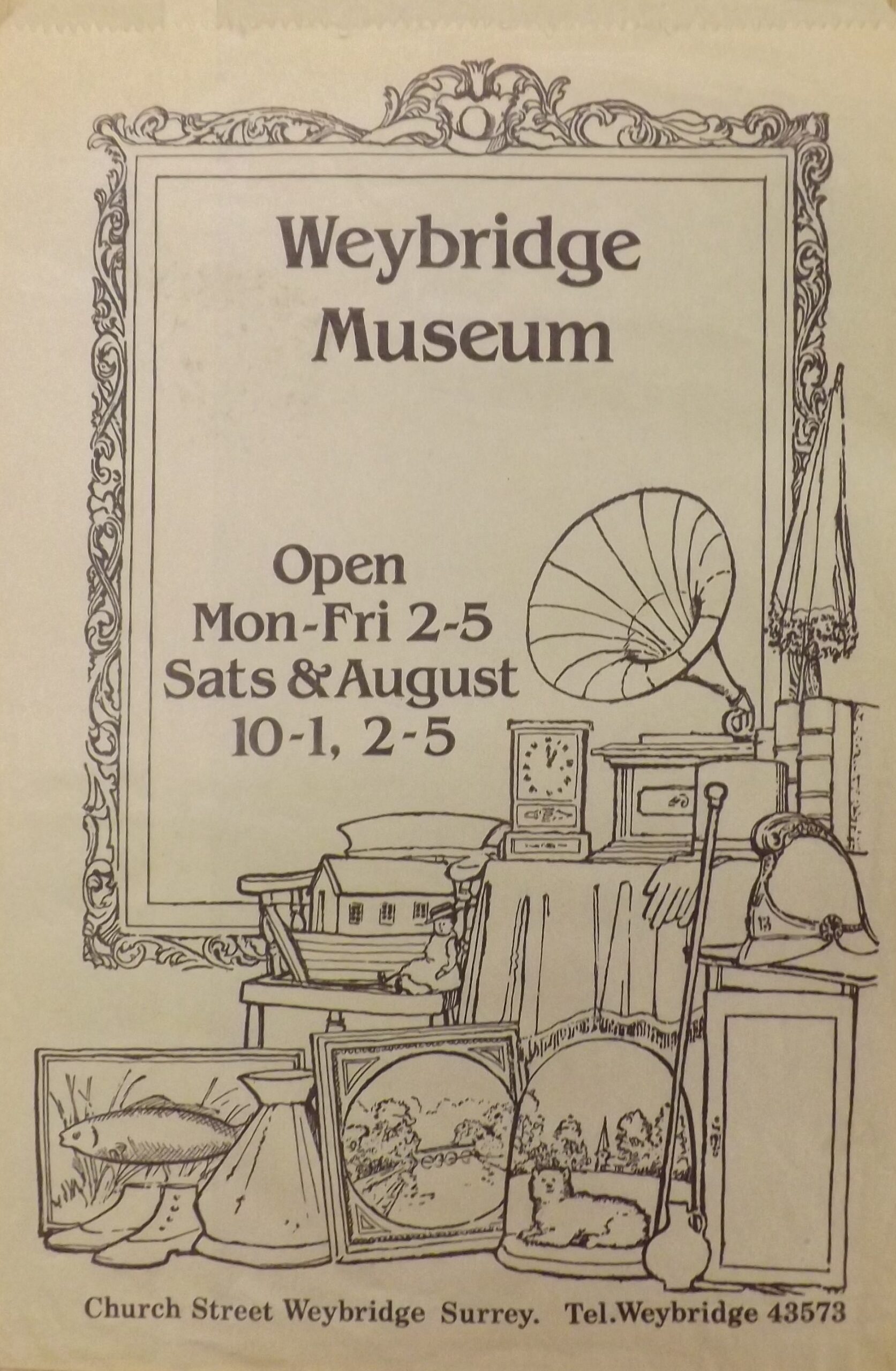 Paper bag from the former Weybridge Museum shop, 1974.
Paper bag from the former Weybridge Museum shop, 1974.
 Paper bag from the former Elmbridge Museum shop, c.1990s.
Paper bag from the former Elmbridge Museum shop, c.1990s. In addition to the traditional shops, High Streets since the 1950s have acted as a centre for communication and news dissemination. Without mobile phones or the internet in the 1950s—70s, the High Street was where newspapers were bought and sold, letters posted, and where new advances in technology and communication, such as televisions, first came into contact with buyers.
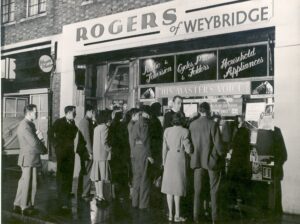
People watching early television displays at night in the shop window of Rogers & Sons, Walton High Street, c.1950s.
A Sign for the Coronation, Rogers & Sons, 1953
Opening in March 1955, Cobham’s Woolworths at number 16 High Street was their first self-service branch in the country. Woolworths had initially opened in the UK in 1909 but this store was the first to use the concept of customers putting items in a basket themselves and then taking them to a checkout desk to pay. Staff were trained to answer customer questions as there was at first fear of backlash at this ‘un-British’ practice, but the idea quickly caught on and is the way that the majority of stores operate today.
“It had a ‘clompy’ lino-on-timber floor, two aisles and no trolleys, just baskets. If I was good, mum would buy me a quarter of hot peanuts in a normal paper bag that oozed grease. We often sat and ate them on the patch of grass in front of the gas showrooms next door. I remember seeing my first pre-packed plastic bag of peanuts and thinking how awful it was having to eat them cold!”
“I loved this Woolworths – it had mini wire shopping baskets (child size) which is awesome when you’re 8! I remember buying a nativity set in there in 1973.”
“I got all my toy soldiers there. In fact, I got everything there.”

Woolworths at 16 Cobham High Street, c.1950s-60s. Courtesy of Terry Gale (left), and The former site of Woolworths, now occupied by Lloyds Pharmacy. Courtesy of Mark Worsfold (right). Both contributed by Cobham Conservation & Heritage Trust.
“My grandparents Harry Payne and Elizabeth Payne purchased 63 High Street Walton in the 1910’s it was run as a tobacconist and confectioners. It was gradually extended back to make the shop bigger.
All the display units were made by by Grandfather from mahogany as he was a master joiner. In the mid 60’s my mother converted it to offices upstairs by erecting outdoor stairs into what was my bedroom. Mr. Labatouche rented upstairs, later Bigmore Associates moved in. Downstairs was rented by a Wimpey Bar.
We had a large garden at the back with 2 greenhouses, vegetable plots with cold frames, fruit trees and canes and flower beds. Grandad cultivated coleus plants that he used to give for free to customers. He was a keen photographer and had a dark room under the stairs where he would develop the photos and give for free to the subjects that he had taken.”
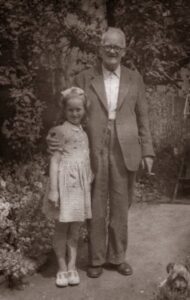
The donor with her grandfather Harry Payne in the back garden of H.G Payne’s. Contributed by Sandra K.

H G Payne’s, Confectioner & Tobacconist, Walton High Street, c.1950s. Contributed by Sandra K.
“Mr Wiseman and my Nan initially lived in the flat. After the war, my father (Colin Worsfold), demobbed from the RAF, came back to Cobham and worked for Mr Wiseman, lodging on the sofa’. Then in 1951 ‘….he ended up courting a marrying, Mr Wiseman’s step-daughter; my mother! Mr & Mrs Wiseman, therefore moved to a flat above a corner shop that stood at the corner of Freelands & Anyards Road (also sadly demolished)… where Majestic Wine is now. This meant my parents and their growing family could have the whole flat above Farrants for themselves. Our lounge bay windows afforded us magnificent views of the High Street.
There were benefits of living above a sweet shop. My father used to have a giant display Easter Egg in the shop window every year. We used to pray that the Easter weekend would be hot and sunny. Then this egg would melt and my father would let us children have it.
One Sunday my parents noticed how quiet the children were and set out to find us. Sure enough, downstairs, they discovered why. The corridor to the flat had shelving along it on which stock for the shops was stored. Apparently, quite a sight beheld them (my youngest brother and I were still in nappies!). My elder sister and brother had decided to lead an ‘expedition’ to taste all the easter eggs. We were covered in chocolate and had poked little holes in each and every egg!

Farrants before refurbishment c.2014. Courtesy of I Lawton, contributed by Cobham Conservation & Heritage Trust.
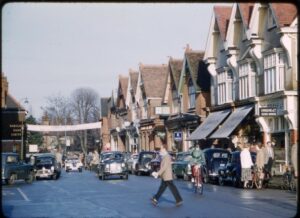
Cobham High Street with Farrants on the right, December 1956. Courtesy of I Lawton, contributed by Cobham Conservation & Heritage Trust.
In the ‘good old days’, when there was half day closing, no shops were open on Sundays, Bank holidays etc Farrants used to have newspaper racks outside the front of the shop. If the shop was closed customers could buy a newspaper and, trustful as we were in those days, would put the money through the letter box. As you can imagine this was mainly made up of a lot of loose change. Whilst not quite slave labour, and far too time consuming for my parents, from a very early age, a task for us kids was to count up this change and put it in little money bags, ready for taking to the Bank. Not knowing the true value on money (I still don’t) we used to make little towers out of the coins and built all sorts of forts and castles on the sitting-room floor! Only to knock them down and have to start again!”
My grandma worked in Paynes. Her name was Dorothea Wells (nee Coleman), known as Dorothy or Dol. I’d love for Sandra K to get in touch with any memories she has of her.
To Pat C - the famous actress you were stood behind in Woolworths could well have been Julie Andrews (Julia Wells) who is my 2nd cousin.
You need to be logged in to comment.
Go to login / registerFashion really took off in the 1960s. Although tailors, cobblers, shoe shops and drapers had always existed on the High Street, the disposable culture of the 60s continued to expand, and consumers looked to buy ready-made clothes rather than materials to make them, new shoes rather than having old ones repaired.
A few core stores hung on in the High Street —often family businesses like Ruffle’s, Bannister’s, and Hicks’, who had started up long before the war — but even these have died out as their owners retired.
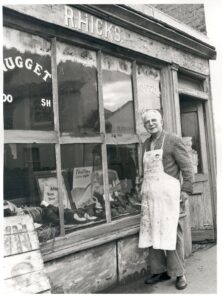
Mr Hicks standing outside his cobblers shop, 1976.
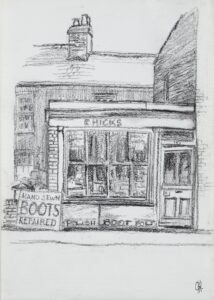
Charcoal drawing by Richard Haynes of R. Hicks’ shop.
Store: R Hicks’ Cobblers
Location: 146 Bridge Road, East Molesey
What is it now? Studio 144 art and craft store
Robert Hicks decided to follow in his father’s footsteps by becoming a cobbler.
He started up his cobbler’s store in 1946, and worked there until his retirement in 1976.
His shop became very well-established over the years, and these pictures were featured in a local newspaper.
“We used to [make shoes from scratch] in Kingston when I worked with my father… we used to make some shoes in the shop… according to people’s measurements. And we used to make them for a guinea.. [After moving to Molesey] Father and I often used to walk… at Esher, and come back through Ditton, or go around through the lion gates at Bushy Park, come back round Hampton way, or down along the river round Hurst Park and back home, before we started work.” (from an oral history recording donated by Esher Local History Society)
Newspaper article, October 1976
“My wife and I moved to Thames Ditton in 1976 to a house we could ill-afford and which was severely under-furnished.
The village boasted three butchers, two fruit and veg shops and a petrol station along with the Daily Fresh food store, Furnish bakers, Andrews hardware, and Tilley where one could buy newspapers, sweets, toys – and have a haircut.
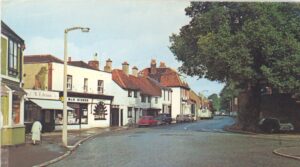
Shops opposite the fountain in Thames Ditton High Street c.1960s, roughly where Bert Carr’s store was situated.
In company with many, we were most excited by The Junkery. Located along the passageway adjacent to View, the site is now occupied by A V Buyer House. Back then it was where Fern Cottage Antiques at No. 42, (still an antique shop), disposed of its inferior stock. For people like us, who were hunting for second-hand furniture for their homes, it was an Aladdin’s cave. When consignments of fresh stock from house clearances arrived, residents of Thames Ditton would descend upon the ramshackle store like bees around a honeypot. The better-quality pieces would be displayed at Fern Cottage Antiques, but we were happily content to root among the discards at The Junkery. Even now I have some sticks of furniture that were discovered there.
One day I arrived home with a non-working but cheap round-dial wall clock that I’d bought at a London auction house. My wife suggested I took it for repair to a chap called Bert Carr who she noticed had a tiny clock shop, opposite the fountain at 53a the High Street… I proudly showed him my purchase. After a quick look, he turned up his nose and said, “That’s rubbish, mate. It’s a Mickey Mouse clock! It’ll only keep going for 36 hours.” He went on to explain that if I wanted a proper clock it would need to have a fusee movement. I was given a swift and impressive horology lesson.
Armed with Bert Carr’s advice I successfully bid for a clock which met with his approval. He overhauled it and replaced broken parts. Forty years on it still keeps perfect time. I would pop in to have a chat with Bert whenever I was in the village. These conversations sparked an increasing interest in clocks, and, over time, I bought a further four wall clocks at auction, all of which Bert restored….
A rough-diamond, beloved by many. Bert died some years ago but my many clocks tick in lasting memory of one of the High Street’s great characters.”
“The first I knew of the floods was when the children were sent home from school. My son Fin came home and said the water was coming across the palying field, he then went out ans started filling sandbags.
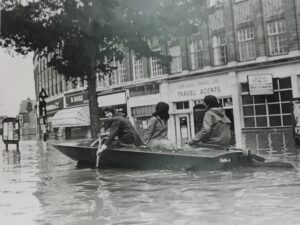
People in a boat in Walton Road, Molesey, in the 1968 floods. Copyright H Storey.
My daughter Mary was at Brooklands College and they were also sent home, when she arrived back in Molesey the water in the High Street was already about 3 foot deep. She was carried shoulder high the length of the High Street by a school friend.
Fortunately for us the water stopped at the corner of the High Street approaching the hospital, it was then coming round the back of the hospital which had to be evacuated….
One thousand pounds worth of food was sent in – I think it was from Payless of Esher High Street. This all ended up in my front garden. I was one of the very few not to have any damage from these floods, at night my frontroom was used as a storeroom, in the mornings bread and milk arrived to give to people as required, in the evenings hot soup and food was brought round with many other products such as baby food and nappies.
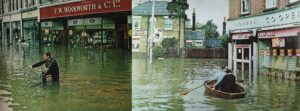
The 1968 floods in Molesey. Contributed by the Molesey Local History Society.
The funny side (there always is one) – this was the day the hospital was evacuated, one of the local doctors arrived at the dry area, after having rowed from Walton Road along the High Street and tied his dinghy to the school railings, looking very smart in jacket, shirt, tie, trunks and plimsolls, and of course his black bag, he entered the hospital on the duckboards that had to be used. I left my front door unlocked at night, the service men could then come in and make tea or coffee: if they got detached from the group they were working with they had to report back to Imber Court – this was their base a long way back (you could leave your doors unlocked in those days). The police came in on one occasion for tea / coffee and had and emergency call. Somebody’s chickens were all floating down the road (Down Street).
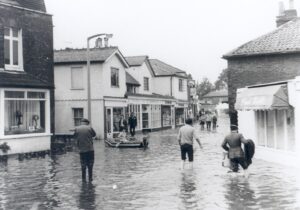
Pedestrians in flood water in the Village High Street, Thames Ditton, September 1968.
The most distressing time was the clearing up, all residents were told to put anything that had been contaminated by flood water on the the pavement outside their homes for collection on the Sunday morning. The refuse carts came and were lined up from outside the hospital and all the way along Approach Road. When I looked back up the High Street there were carpets, chairs, tables, 3-piece suits, cookers, fridges – anything that had been touched by the four feet of flood water that most people in the High Street, Molesey Road and Approach Road had. It was devastating. How lucky I had been.”
My grandma worked in Paynes. Her name was Dorothea Wells (nee Coleman), known as Dorothy or Dol. I’d love for Sandra K to get in touch with any memories she has of her.
To Pat C - the famous actress you were stood behind in Woolworths could well have been Julie Andrews (Julia Wells) who is my 2nd cousin.
You need to be logged in to comment.
Go to login / registerAs well as being important to businesses, entertainment and social life across Elmbridge, a selection of our primary streets and landmarks also have some surprising links to the British Empire. Discover them in our Objects of Empire exhibition, where we examine how the Empire influenced our local landscape.
Go to the Objects of Empire Online Exhibition
Add your own memories!
Do you remember anything about Elmbridge food shops? We want to hear your memoriesMy grandma worked in Paynes. Her name was Dorothea Wells (nee Coleman), known as Dorothy or Dol. I’d love for Sandra K to get in touch with any memories she has of her.
To Pat C - the famous actress you were stood behind in Woolworths could well have been Julie Andrews (Julia Wells) who is my 2nd cousin.
You need to be logged in to comment.
Go to login / register